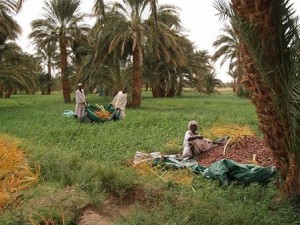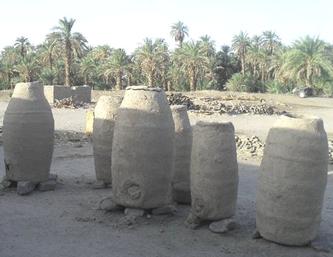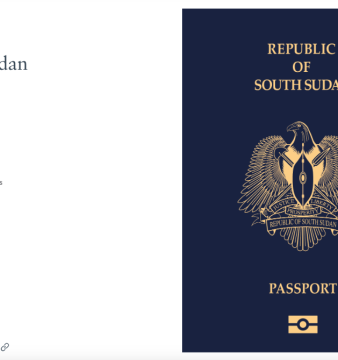A year among farmers (part 2)

“Hash Albalah” (dates harvest),collection of dates from “sabitas” (date clusters) (Photo :Osman M.Salih)
I felt strangely at home, when I spent a year in Mojarrab, my family hometown in a region north of Dongola, but this city boy knew little about farmer’s culture.
After a “quiet” summer of rest, weddings, relatives visits and farmers travel, “Toot” (September in the farmers Pharaonic-Coptic calendar) was upon us; a time to harvest “Alnakheel” (palm trees), the region’s main crop.
“Alnakhla” fruit is “palah” or “tamr” (dates); famous fruit types are: “Barakawi,” and “Mishriq” .“Alnakhla” is “dioecious,” has separate male and female plants. They can be grown from seeds, but only half of seedlings will be female and, hence, fruit bearing. Therefore, most planting is from cutlings (Fasela). Because natural pollination occurs with about an equal number of male and female plants, “Alnakhla” is pollinated manually, and one male can pollinate about 100 females.
In Dongola region, “Hash Albalah” (dates harvest) was in “Toot” (September) and the pollination was in “Omsheer” (February) and “Baramhat” (March). It was done by skilled men who carefully and tactfully climbed the trees.
“Kallok” (Nubian for green un-ripped fruit) appeared in early summer, and as “samoom” (hot winds) plowed, the green color became yellow, “Rutab” (“Kojkol” in Nubian), then it’s ready for harvest when it turns dark brown.
Women participate in the harvesting, but a man was always needed to climb the tree, cut and throw “sabitas” (date clusters). Children, partly playing, partly eating and partly helping, were there too. The date was left under the sun to dry, and then packed in sacks to be sent abroad. In each farmer’s home there was a “gossaiba” (tall mud pin) to store dates for the family’s yearly consumption.

The “gossaiba” (tall mud pin) to store some date for family all year consumption (Photo: copy from wadikh.net)
I found that “Alnakhla” is more than just a plant. It is part of the culture; the stump, branches and leaves are used to build homes. The harvest season is also the season of weddings, relatives’ visits and festivals. The plants are inherited, generation after a generation; many expatriates inherited trees, and when they returned, they not only check on their trees, eat their dates, but they also felt the bond with their fathers and the grandfathers.
As I felt that bond, it was time for winter season.
(To Be Continued)
Featured image by Tome Allen




